Low Thermal Conductivity Materials and Very Low Heat Power: A Demanding Challenge in the Detection of Flaws in Multi-Layer Wooden Cultural Heritage Objects Solved by Pulse-Compression Thermography Technique
Abstract
1. Introduction
2. Pulse-Compression Thermography (PuCT)
- (1)
- The sample is excited via a periodic (two periods) Legendre sequence-modulated heating stimulus of order 31, each bit having a duration of 1 s, leading to an overall duration of the stimuli T = 62 s;
- (2)
- Thermograms are acquired for an overall time interval T;
- (3)
- The step-heating removal procedure (Fitting) is applied pixelwise to the of the acquired thermogram sequence for obtaining ;
- (4)
- The PuC algorithm is performed by convolving only the second period of with , thus retrieving , as for Equation (2). Note that is just the time reversal of a single period of the periodic Legendre sequence.
3. Material and Methods
3.1. Sample Realization
3.2. Experimental Setups
4. Discussion
5. Conclusions
Author Contributions
Funding
Conflicts of Interest
References
- Maldague, X. Theory and Practice of Infrared Technology for Non-Destructive Testing; Wiley: Hoboken, NJ, USA, 2001; 704p. [Google Scholar]
- Schirripa Spagnolo, G.; Ambrosini, D.; Paoletti, D. Comparative study on the efficiency of some optical methods for artwork diagnostics. In Proceedings of the SPIE—The International Society for Optical Engineering—Laser Technique and Systems in Art Conservation, Munich, Germany, 22 October 2001; Volume 4402. [Google Scholar]
- Castellini, P.; Abaskin, V.; Achimova, E. Portable electronic interferometry device for the damages measurements in veneered wood artworks. J. Cult. Herit. 2008, 9, 225–233. [Google Scholar] [CrossRef]
- Ibarra-Castanedo, C.; Sfarra, S.; Ambrosini, D.; Paoletti, D.; Bendada, A.; Maldague, X. Subsurface defect characterization in artworks by quantitative pulsed phase thermography and holographic interferometry. QIRT J. 2008, 5, 131–149. [Google Scholar] [CrossRef]
- Ibarra-Castanedo, C.; Sfarra, S.; Ambrosini, D.; Paoletti, D.; Bendada, A.; Maldague, X. Diagnostics of panel paintings using holographic interferometry and pulsed thermography. QIRT J. 2010, 7, 85–114. [Google Scholar] [CrossRef]
- Sfarra, S.; Ibarra-Castanedo, C.; Theodorakeas, P.; Avdelidis, N.P.; Paoletti, A.; Paoletti, D.; Hrissagis, K.; Bendada, A.; Koui, M.; Maldague, X. Holographic interferometry (HI) and active infrared thermography (IRT) for the non-destructive assessment of esteemed hand-painted ceramic sample panels. In Proceedings of the NDT in Progress 2011—6th International Workshop of NDT Experts, Prague, Czech Republic, 10–11 October 2011. [Google Scholar]
- Sfarra, S.; Theodorakeas, P.; Ibarra-Castanedo, C.; Avdelidis, N.P.; Paoletti, A.; Paoletti, D.; Hrissagis, K.; Bendada, A.; Koui, M.; Maldague, X. Importance of integrated results of different non-destructive techniques in order to evaluate defects in panel paintings: The contribution of infrared, optical and ultrasonic techniques. In Proceedings of the SPIE—The International Society for Optical Engineering—O3A: Optics for Arts, Architecture, and Archaeology III, Munich, Germany, 6 June 2011; Volume 8084. [Google Scholar]
- Sfarra, S.; Theodorakeas, P.; Ibarra-Castanedo, C.; Avdelidis, N.P.; Paoletti, A.; Paoletti, D.; Hrissagis, K.; Bendada, A.; Koui, M.; Maldague, X. Evaluation of defects in panel paintings using infrared, optical and ultrasonic techniques. Insight Non-Destr. Test. Cond. Monit. 2012, 54, 21–27. [Google Scholar] [CrossRef]
- Vrabie, V.; Perrin, E.; Bodnar, J.-L.; Mouhoubi, K.; Detalle, V. Active IR thermography processing based on higher order statistics for non-destructive evaluation. In Proceedings of the 20th European Signal Processing Conference (EUSIPCO), Bucharest, Romania, 27–31 August 2012; pp. 894–898. [Google Scholar]
- Gavrilov, D.; Maeva, E.; Grube, O.; Vodyanoy, I.; Maev, R. Experimental comparative study of the applicability of infrared techniques for non-destructive evaluation of paintings. J. Am. Inst. Conserv. 2013, 52, 48–60. [Google Scholar] [CrossRef]
- Gavrilov, D.; Maeva, E.; Maev, R.G. Thermographic inspection in the service of art science: Theory, methods and considerations. Insight Non-Destruct. Test. Cond Monit. 2014, 56, 131–136. [Google Scholar] [CrossRef]
- Bendada, A.; Sfarra, S.; Ibarra-Castanedo, C.; Akhloufi, M.; Caumes, J.-P.; Pradere, C.; Batsale, J.-C.; Maldague, X. Subsurface imaging for panel paintings inspection: A comparative study of the ultraviolet, the visible, the infrared and the terahertz spectra. Opto-Electron. Rev. 2015, 23, 88–99. [Google Scholar] [CrossRef]
- Sfarra, S.; Theodorakes, P.; Ibarra-Castanedo, C.; Avdelidis, N.P.; Ambrosini, D.; Cheilakou, E.; Paoletti, D.; Koui, M.; Bendada, A.; Maldague, X. How to retrieve information inherent to old restorations made on frescoes of particular artistic value using infrared vision? Int. J. Thermophys. 2015, 36, 3051–3070. [Google Scholar] [CrossRef]
- Ahmad, M.Z.; Khan, A.A.; Mezghani, S.; Perrin, E.; Mouhoubi, K.; Bodnar, J.-L.; Vrabie, V. Wavelet subspace decomposition of thermal infrared images for defect detection in artworks. Infrared Phys. Technol. 2016, 77, 325–334. [Google Scholar] [CrossRef]
- Buchta, D.; Heinemann, C.; Pedrini, G.; Krekel, C.; Osten, W. Lock-in-shearography for the detection of transport-induced damages on artwork. In Proceedings of the SPIE—The International Society for Optical Engineering—Optics for Arts, Architecture, and Archaeology VI, Munich, Germany, 11 July 2017; Volume 10331. [Google Scholar]
- Sfarra, S.; Fernandes, H.C.; López, F.; Ibarra-Castanedo, C.; Zhang, H.; Maldague, X. Qualitative assessment via infrared vision of sub-surface defects present beneath decorative surface coatings. Int. J. Thermophys. 2018, 39, 13. [Google Scholar] [CrossRef]
- Peeters, J.; Van der Snickt, G.; Sfarra, S.; Legrand, S.; Ibarra-Castanedo, C.; Janssens, K.; Steenackers, G. IR reflectography and active thermography on artworks: The added value of the 1.5-3 μm band. Appl. Sci. 2018, 8, 50. [Google Scholar] [CrossRef]
- Palomar, T.; Agua, F.; Gómez-Heras, M. Comparative assessment of stained-glass windows materials by infrared thermography. Int. J. Appl. Glass Sci. 2018, 9, 530–539. [Google Scholar] [CrossRef]
- Stamatopoulou, E.; Karoglou, M.; Bakolas, A. Contemporary artworks created on photosensitized cement: Materials and conservation state of Nikos Kessanlis “Wall-Erotica”. J. Cult. Herit. 2019, in press. [Google Scholar] [CrossRef]
- Laureti, S.; Malekmohammadi, H.; Rizwan, M.K.; Burrascano, P.; Sfarra, S.; Mostacci, M.; Ricci, M. Looking through paintings by combining hyper-spectral imaging and pulse-compression thermography. Sensors 2019, 19, 4335. [Google Scholar] [CrossRef] [PubMed]
- Laureti, S.; Colantonio, C.; Burrascano, P.; Melis, M.; Calabrò, G.; Malekmohammadi, H.; Sfarra, S.; Ricci, M.; Pelosi, C. Development of integrated innovative techniques for paintings examination: The case studies of The Resurrection of Christ attributed to Andrea Mantegna and the Crucifixion of Viterbo attributed to Michelangelo’s workshop. J. Cult. Herit. 2019, 40, 1–16. [Google Scholar] [CrossRef]
- Bodnar, J.L.; Nicolas, J.L.; Candoré, J.C.; Detalle, V. Non-destructive testing by infrared thermography under random excitation and ARMA analysis. Int. J. Thermophys. 2012, 33, 2011–2015. [Google Scholar] [CrossRef]
- Sfarra, S.; Theodorakeas, P.; Černecký, J.; Pivarčiová, E.; Perilli, S.; Koui, M. Inspecting marquetries at different wavelengths: The preliminary numerical approach as aid for a wide-range of non-destructive tests. J. Nondestruct. Eval. 2017, 36, 6. [Google Scholar] [CrossRef]
- Tavakolian, P.; Sfarra, S.; Gargiulo, G.; Sivagurunathan, K.; Mandelis, A. Photothermal coherence tomography for 3-D visualization and structural non-destructive imaging of a wood inlay. Infrared Phys. Technol. 2018, 91, 206–213. [Google Scholar] [CrossRef]
- Cielo, P.; Maldague, X.; Déom, A.A.; Lewak, R. Thermographic non-destructive evaluation of industrial materials and structures. Mater. Eval. 1987, 45, 452–460. [Google Scholar]
- Allport, J.; McHugh, J. Quantitative evaluation of transient video thermography. In Review of Progress in Quantitative Non-Destructive Evaluation; Thompson, D.O., Chimenti, D.E., Eds.; Plenum Press: New York, NY, USA, 1988; pp. 253–262. [Google Scholar]
- Sikora, A.; František, K.; Gaff, M.; Vondrová, V.; Bubeníková, T.; Kubovskỳ, I. Impact of thermal modification on color and chemical changes of spruce and oak wood. J. Wood Sci. 2018, 64, 406–416. [Google Scholar] [CrossRef]
- Laureti, S.; Sfarra, S.; Malekmohammadi, H.; Burrascano, P.; Hutchins, D.A.; Senni, L.; Silipigni, G.; Maldague, X.P.V.; Ricci, M. The use of pulse-compression thermography for detecting defects in paintings. NDT E Int. 2018, 98, 147–154. [Google Scholar] [CrossRef]
- Silipigni, G.; Burrascano, P.; Hutchins, D.A.; Laureti, S.; Petrucci, R.; Senni, L.; Torre, L.; Ricci, M. Optimization of the pulse-compression technique applied to the infrared thermography nondestructive evaluation. NDT E Int. 2017, 87, 100–110. [Google Scholar] [CrossRef]
- Laureti, S.; Silipigni, G.; Senni, L.; Tomasello, R.; Burrascano, P.; Ricci, M. Comparative study between linear and non-linear frequency-modulated pulse-compression thermography. Appl. Opt. 2018, 57, D32–D39. [Google Scholar] [CrossRef] [PubMed]
- Laureti, S.; Khalid Rizwan, M.; Malekmohammadi, H.; Burrascano, P.; Natali, M.; Torre, L.; Rallini, M.; Puri, I.; Hutchins, D.; Ricci, M. Delamination Detection in Polymeric Ablative Materials Using Pulse-Compression Thermography and Air-Coupled Ultrasound. Sensors 2019, 19, 2198. [Google Scholar] [CrossRef] [PubMed]
- Malekmohammadi, H.; Laureti, S.; Burrascano, P.; Ricci, M. Comparison of optimisation strategies for the improvement of depth detection capability of Pulse-Compression Thermography. Quant. InfraRed Thermogr. J. 2020, 17, 26–39. [Google Scholar] [CrossRef]
- Wu, S.; Gao, B.; Yang, Y.; Zhu, Y.; Burrascano, P.; Laureti, S.; Ricci, M.; Wang, Y. Halogen optical referred pulse-compression thermography for defect detection of CFRP. Infrared Phys. Technol. 2019, 102, 103006. [Google Scholar] [CrossRef]
- Mulaveesala, R.; Tuli, S. Theory of frequency modulated thermal wave imaging for nondestructive subsurface defect detection. Appl. Phys. Lett. 2006, 89, 191913. [Google Scholar]
- Tabatabaei, N.; Mandelis, A. Thermal-wave radar: A novel subsurface imaging modality with extended depth-resolution dynamic range. Rev. Sci. Instrum. 2009, 80, 034902. [Google Scholar] [CrossRef]
- Mulaveesala, R.; Venkata Ghali, S. Coded excitation for infrared non-destructive testing of carbon fiber reinforced plastics. Rev. Sci. Instrum. 2011, 82, 054902. [Google Scholar] [CrossRef]
- Arora, V.; Mulaveesala, R. Pulse compression with gaussian weighted chirp modulated excitation for infrared thermal wave imaging. Prog. Electromagn. Res. Lett. 2014, 44, 133–137. [Google Scholar] [CrossRef]
- Avdelidis, N.P.; Almond, D.P.; Dobbinson, A.; Hawtin, B.C. Pulsed thermography: Philosophy, qualitative and quantitative analysis on certain aircraft applications. Insight Non-Destruct. Test. Monit. 2006, 48, 286–289. [Google Scholar] [CrossRef]
- Carslaw, H.; Jaeger, J. Conduction of Heat in Solids, 2nd ed.; Oxford Clarendon Press: Oxford, UK, 1959; p. 1959. [Google Scholar]
- Burgholzer, P. Thermodynamic Limits of Spatial Resolution in Active Thermography. Int. J. Thermophys. 2015, 36, 2328–2341. [Google Scholar] [CrossRef] [PubMed]
- Turin, G. An introduction to matched filters. IRE Trans. Inf. Theory 1960, 6, 311–329. [Google Scholar] [CrossRef]
- Burrascano, P.; Laureti, S.; Senni, L.; Ricci, M. Pulse Compression in Nondestructive Testing Applications: Reduction of Near Sidelobes Exploiting Reactance Transformation. IEEE Trans. Circuits Syst. I 2018, 99, 1–11. [Google Scholar] [CrossRef]
- Harput, S.; Arif, M.; McLaughlan, J.; Cowell, D.M.; Freear, S. The effect of amplitude modulation on subharmonic imaging with chirp excitation. IEEE Trans. Ultrason. Ferroelectr. Freq. Control. 2013, 60, 2532–2544. [Google Scholar] [CrossRef]
- Rizwan, M.K.; Senni, L.; Burrascano, P.; Laureti, S.; Goldammer, M.; Mooshofer, H.; Ricci, M.; Borgna, R.; Neri, S. Contextual Application of Pulse-Compression and Multi-frequency Distance-Gain Size Analysis in Ultrasonic Inspection of Forging. J. Nondestruct. Eval. 2019, 38, 72. [Google Scholar] [CrossRef]
- Hutchins, D.; Burrascano, P.; Davis, L.; Laureti, S.; Ricci, M. Coded waveforms for optimised air-coupled ultrasonic nondestructive evaluation. Ultrasonics 2014, 54, 1745–1759. [Google Scholar] [CrossRef]
- Ricci, M.; Senni, L.; Burrascano, P. Exploiting pseudorandom sequences to enhance noise immunity for air-coupled ultrasonic nondestructive testing. IEEE Trans. Instrum. Meas. 2012, 61, 2905–2915. [Google Scholar] [CrossRef]
- Hamilton Jackson, F. Intarsia and Marquetry—Handbook for the Designer and Craftsman; Sands and Company: London, UK, 1903; 265p. [Google Scholar]
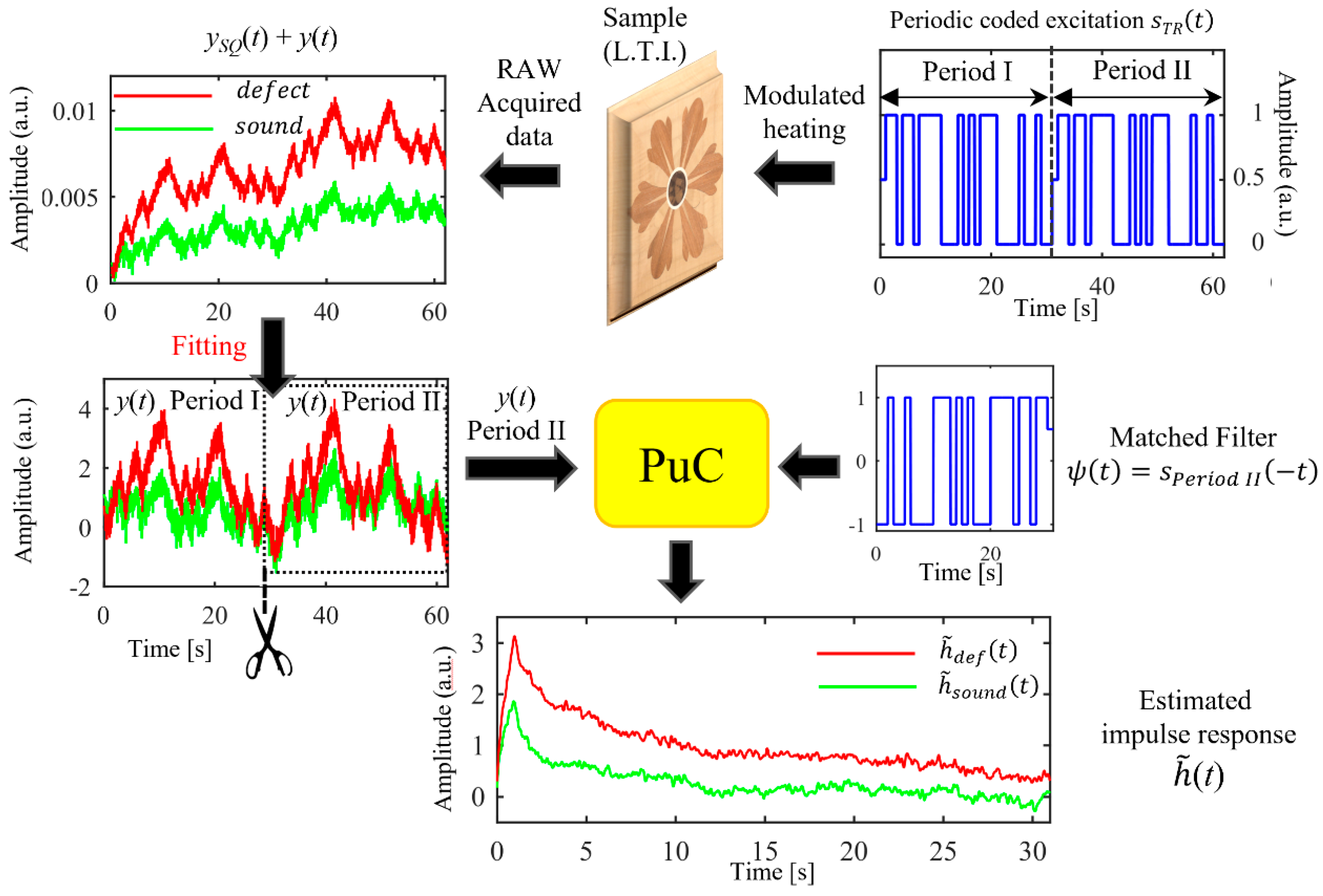
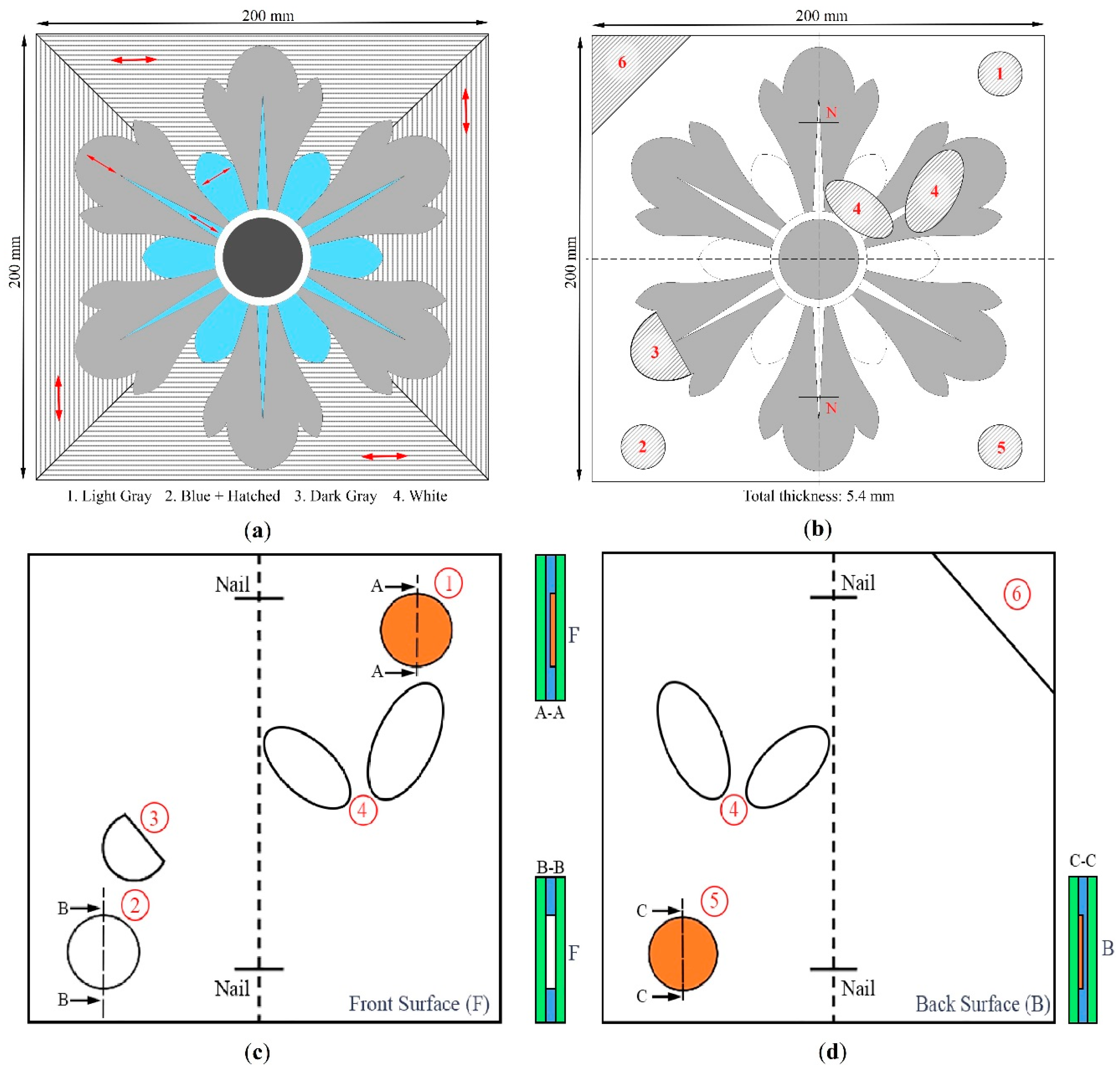
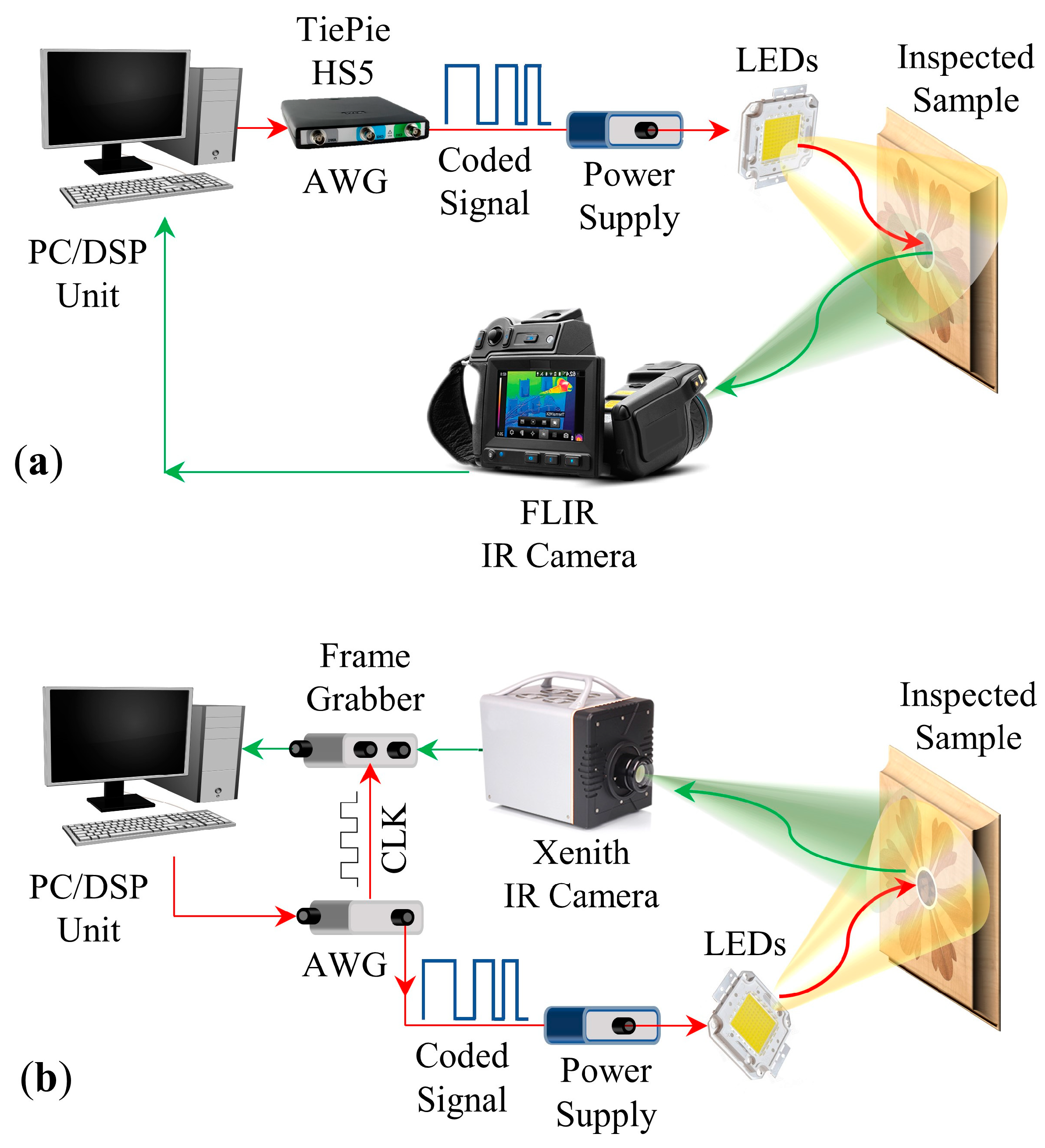
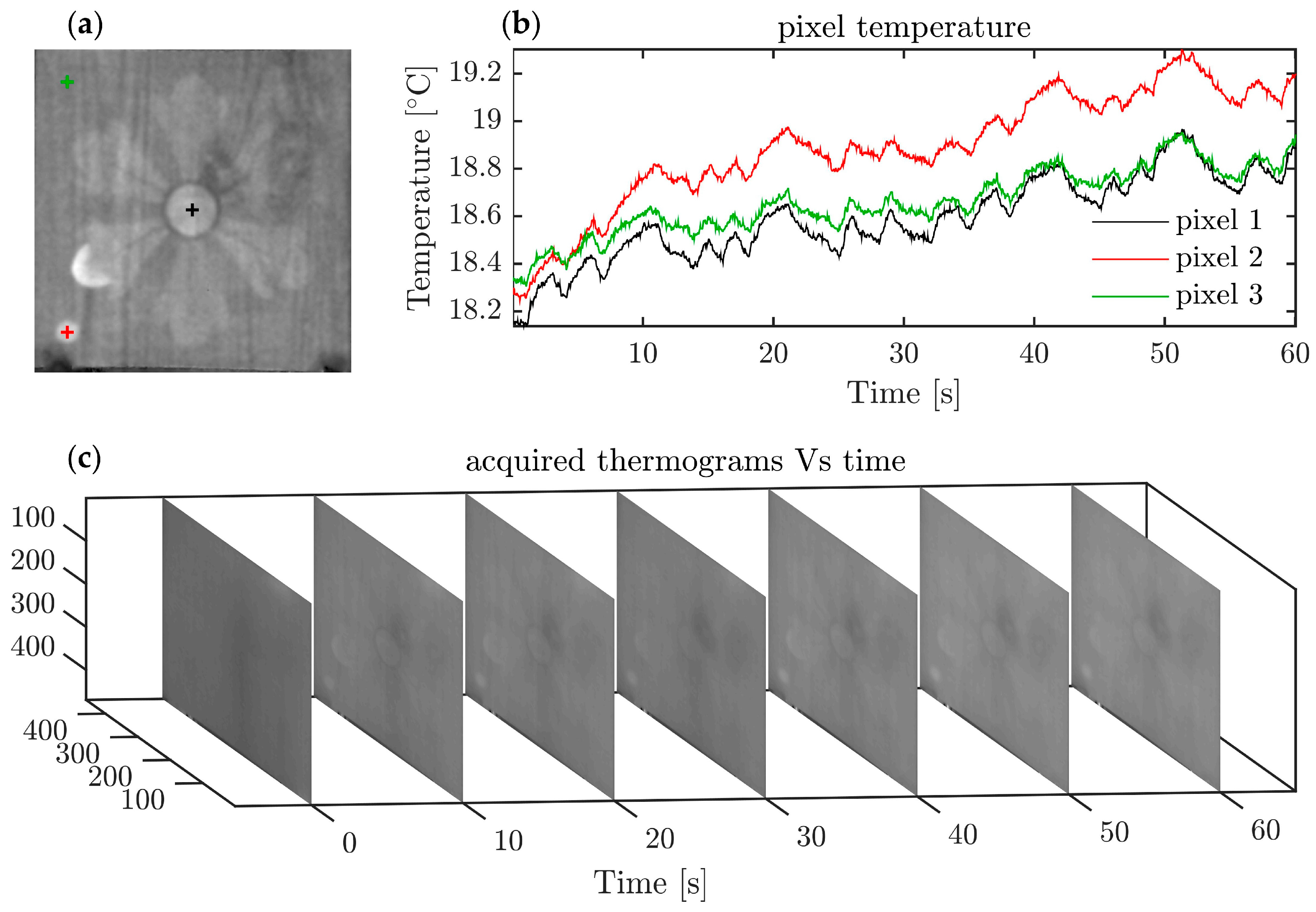
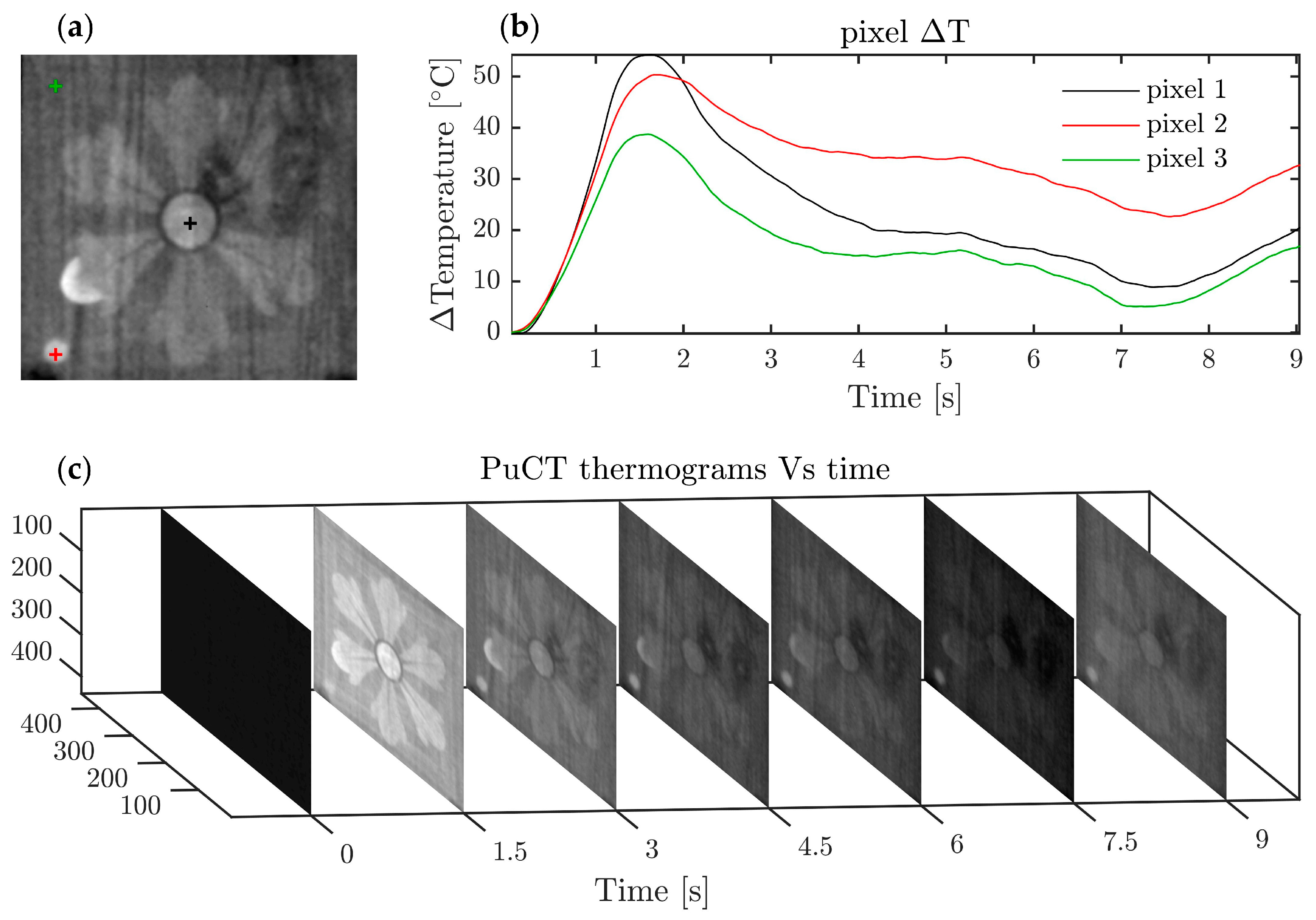
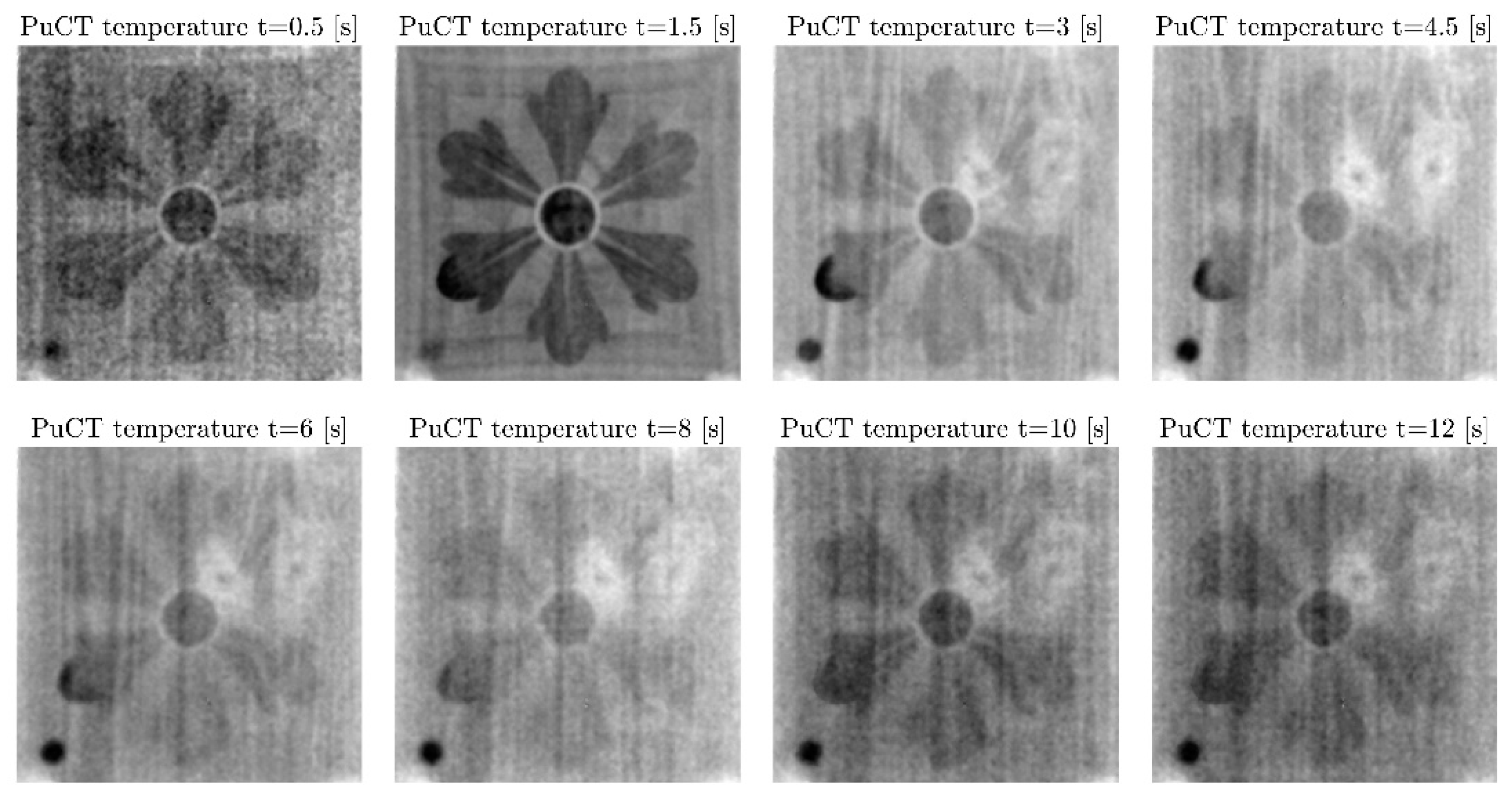
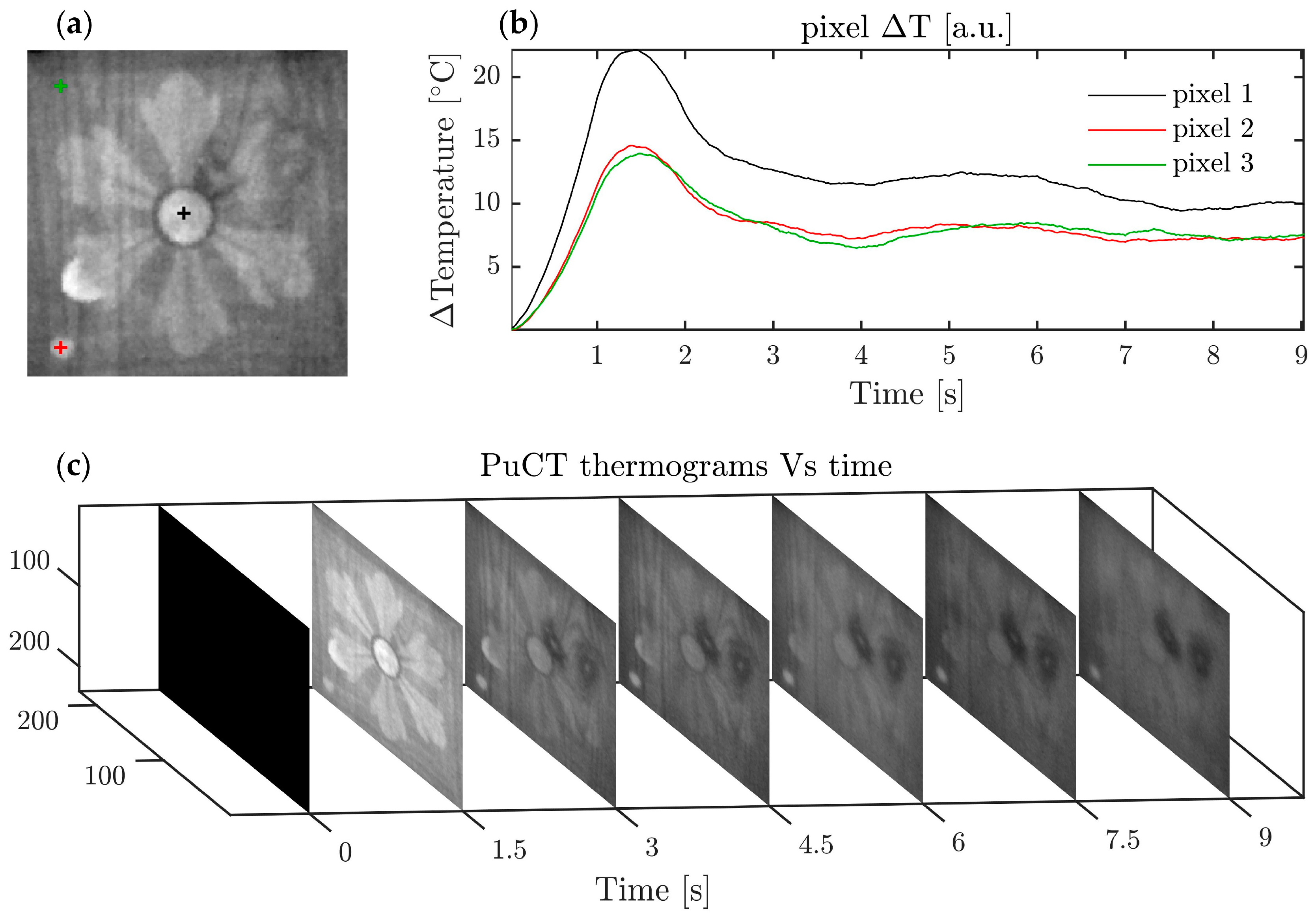
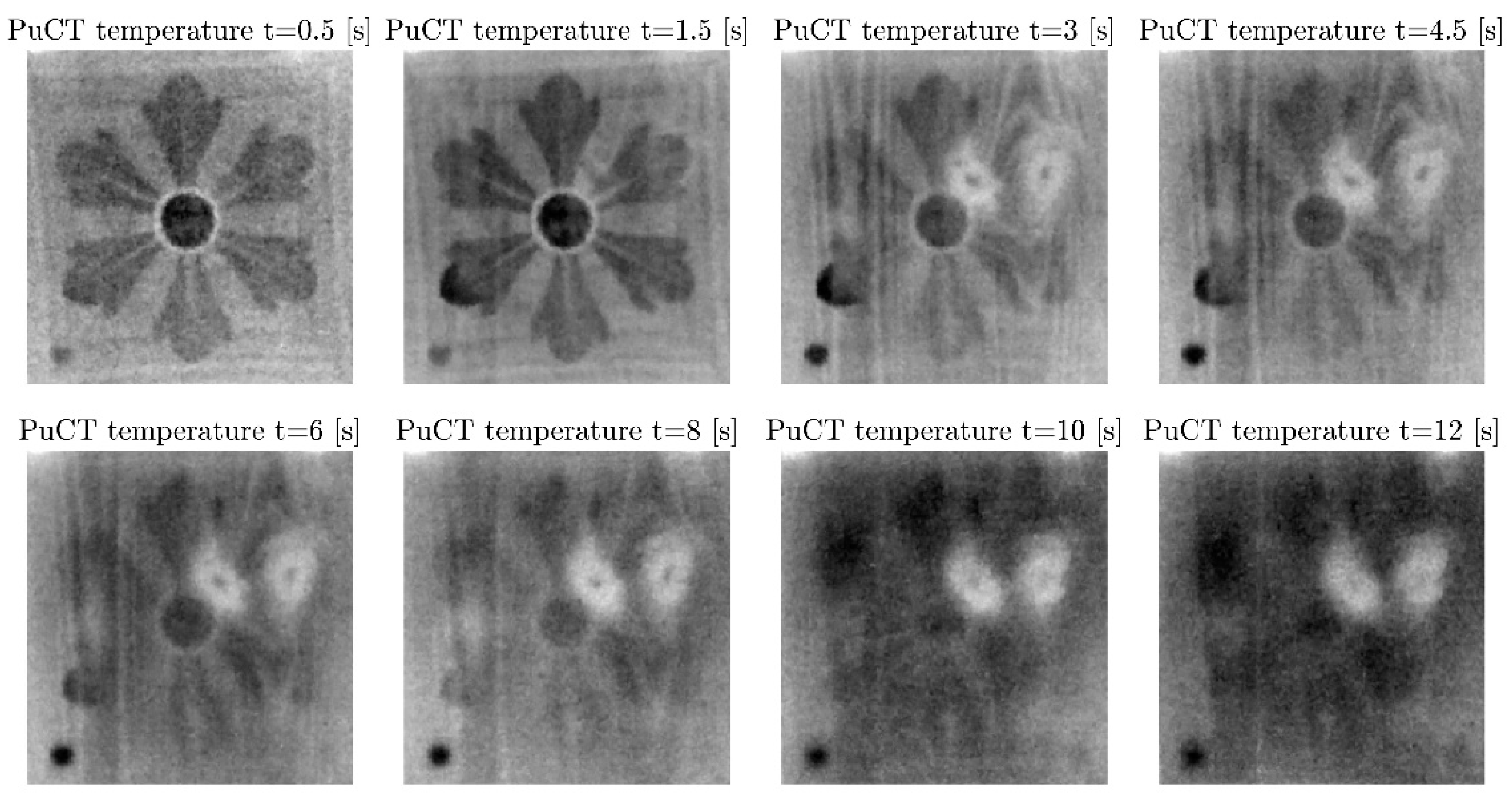
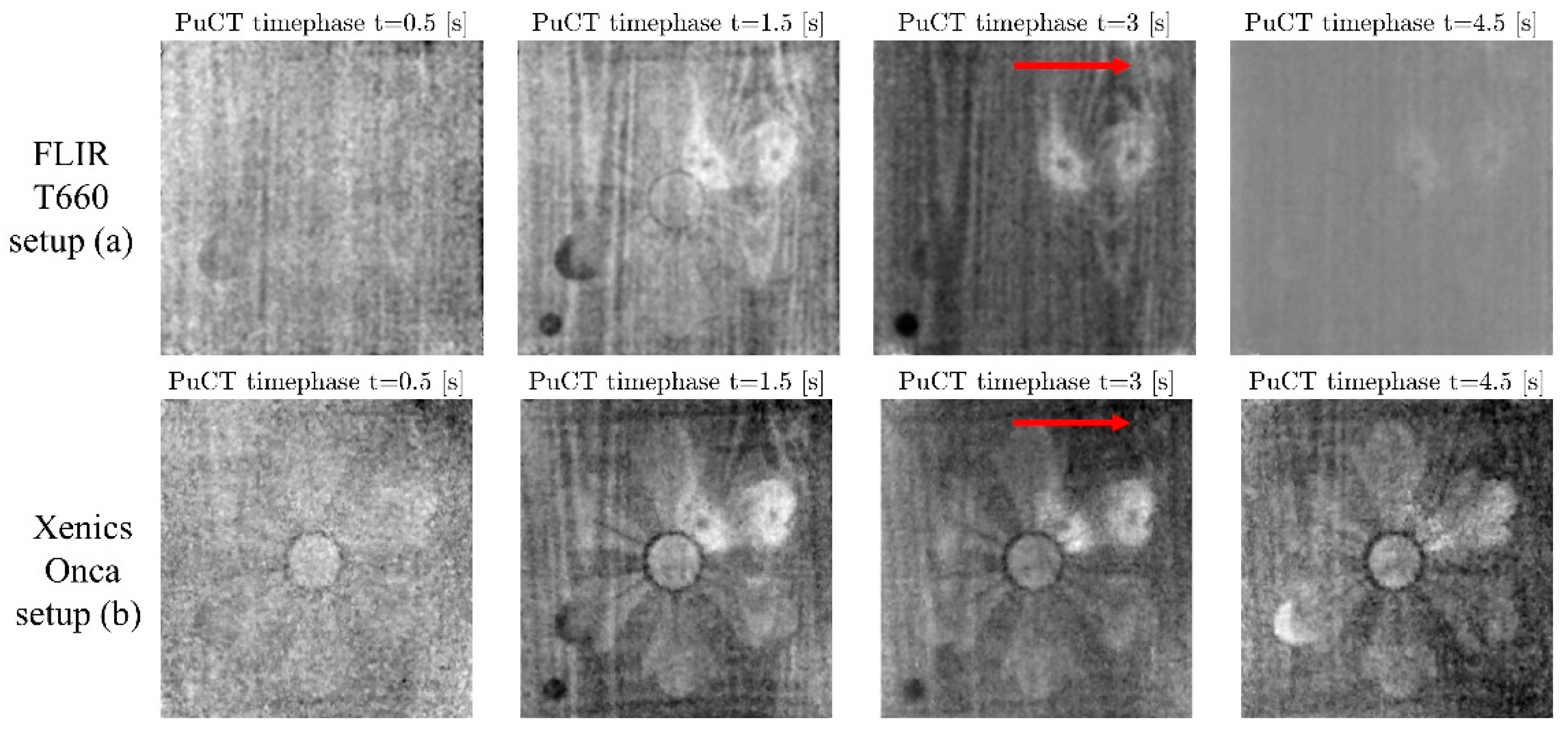
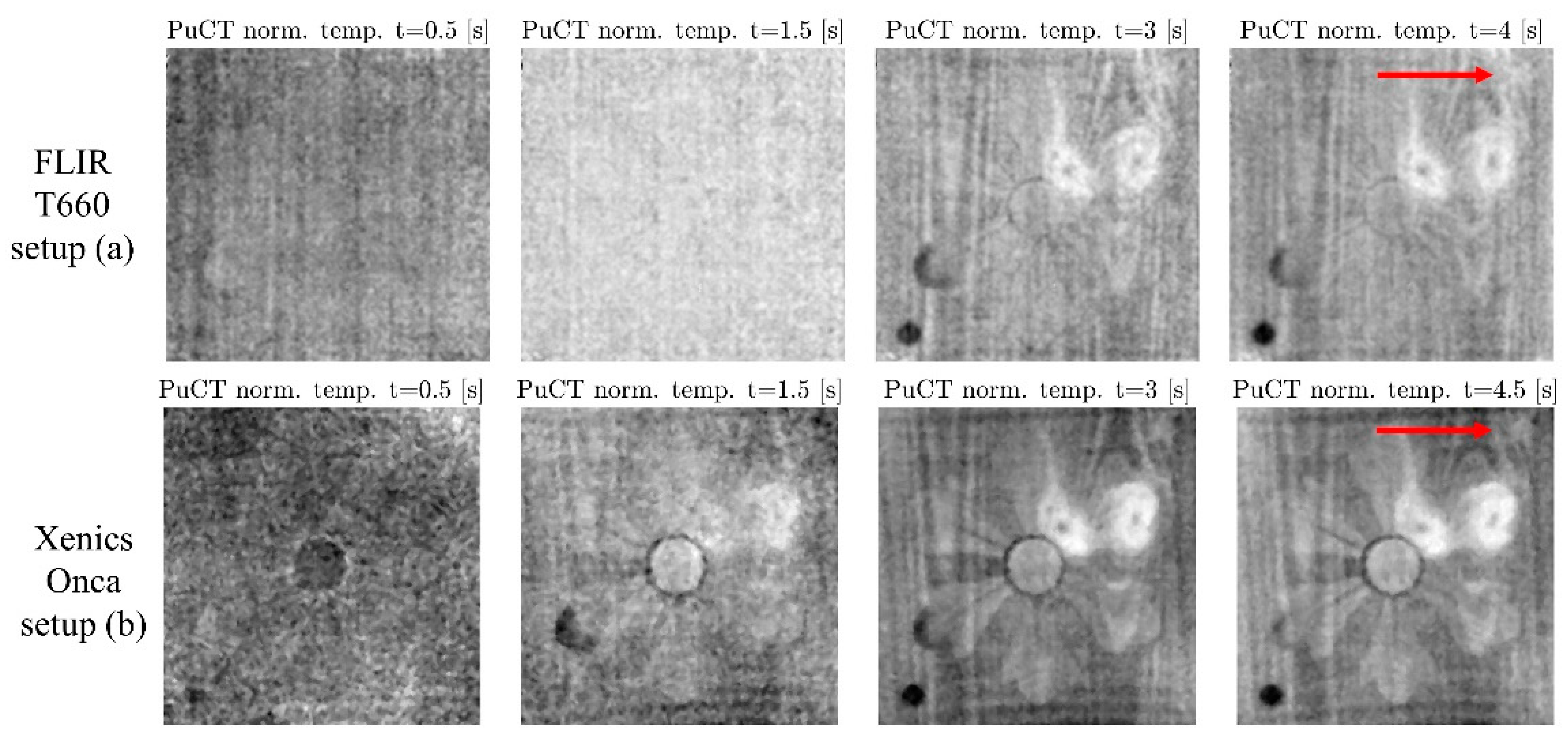
© 2020 by the authors. Licensee MDPI, Basel, Switzerland. This article is an open access article distributed under the terms and conditions of the Creative Commons Attribution (CC BY) license (http://creativecommons.org/licenses/by/4.0/).
Share and Cite
Sfarra, S.; Laureti, S.; Gargiulo, G.; Malekmohammadi, H.; Sangiovanni, M.A.; La Russa, M.; Burrascano, P.; Ricci, M. Low Thermal Conductivity Materials and Very Low Heat Power: A Demanding Challenge in the Detection of Flaws in Multi-Layer Wooden Cultural Heritage Objects Solved by Pulse-Compression Thermography Technique. Appl. Sci. 2020, 10, 4233. https://doi.org/10.3390/app10124233
Sfarra S, Laureti S, Gargiulo G, Malekmohammadi H, Sangiovanni MA, La Russa M, Burrascano P, Ricci M. Low Thermal Conductivity Materials and Very Low Heat Power: A Demanding Challenge in the Detection of Flaws in Multi-Layer Wooden Cultural Heritage Objects Solved by Pulse-Compression Thermography Technique. Applied Sciences. 2020; 10(12):4233. https://doi.org/10.3390/app10124233
Chicago/Turabian StyleSfarra, Stefano, Stefano Laureti, Gianfranco Gargiulo, Hamed Malekmohammadi, Mario Andrea Sangiovanni, Mauro La Russa, Pietro Burrascano, and Marco Ricci. 2020. "Low Thermal Conductivity Materials and Very Low Heat Power: A Demanding Challenge in the Detection of Flaws in Multi-Layer Wooden Cultural Heritage Objects Solved by Pulse-Compression Thermography Technique" Applied Sciences 10, no. 12: 4233. https://doi.org/10.3390/app10124233
APA StyleSfarra, S., Laureti, S., Gargiulo, G., Malekmohammadi, H., Sangiovanni, M. A., La Russa, M., Burrascano, P., & Ricci, M. (2020). Low Thermal Conductivity Materials and Very Low Heat Power: A Demanding Challenge in the Detection of Flaws in Multi-Layer Wooden Cultural Heritage Objects Solved by Pulse-Compression Thermography Technique. Applied Sciences, 10(12), 4233. https://doi.org/10.3390/app10124233










